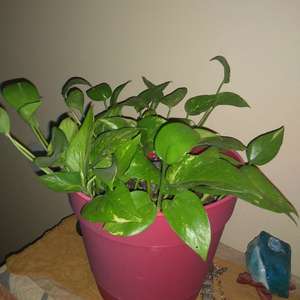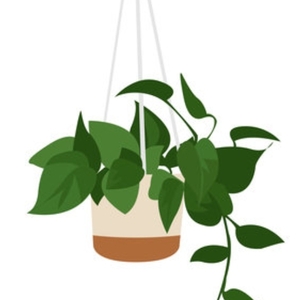文章
Miss Chen
2022年03月05日

Native to the Cebu island in the Philippines, the Cebu blue pothos (Epipremnum pinnatum 'Cebu Blue') is a unique variety of pothos that is highly sought after due to its stunning foliage. Characterized by thin and silvery green-blue leaves, this Instagram-worthy pothos is delightfully easy to keep happy indoors. Unfortunately, as a part of the Epipremnum genus, this pothos is considered toxic to both cats and dogs, so be sure to keep it out of reach if you have pets at home1.
Pothos vs. Philodendron: What's the Difference?
Common Name Cebu blue pothos, blue pothos
Botanical Name Epipremnum pinnatum 'Cebu Blue'
Family Araceae
Plant Type Evergreen, vine
Mature Size 8 ft. long indoors, 40 ft. long outdoors
Sun Exposure Partial
Soil Type Moist but well-drained
Soil pH Acidic, neutral, alkaline
Hardiness Zones 9-11, USA
Native Area Asia
Cebu Blue Pothos Care
As with most of its relatives in the pothos family, the Cebu blue pothos is easy to grow and care for. While it grows naturally outdoors in the Philippines, this pothos is most commonly grown indoors as a houseplant in the United States.
There are two unique growth phases of the Cebu blue pothos: juvenile and mature. The juvenile phase is the most recognizable and is characterized by the familiar small, elongated oval leaves that are silvery blue-green in color. The mature phase is usually only observed in plants that are grown outdoors and is characterized by larger green leaves that develop fenestrations over time.
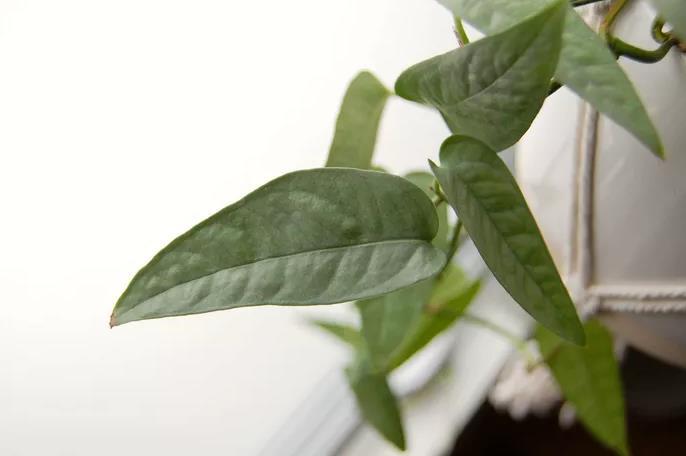
When it comes to care, the biggest difference between these two phases is the growth habit—while all Cebu blue pothos can be trained to grow up a moss pole or trellis, mature Cebu blue pothos are vigorous climbers and do not grow well without support. Otherwise, both juvenile and mature Cebu blue pothos are relatively easy to grow.
Light
To encourage strong, healthy growth, choose a location for your Cebu blue pothos that receives medium to bright indirect light. Unlike other varieties of pothos such as golden pothos or jade pothos, Cebu blue pothos do not do well in low light for extended periods of time. It is also best to avoid direct sunlight as their leaves burn easily.
Soil
Like all pothos plants, the Cebu blue pothos requires moist but well-draining soil. A mixture of one part potting soil, one part orchid bark, and one part perlite provides the perfect amount of drainage.
Water
Allow the top 1 to 2 inches of soil to dry between waterings and then water thoroughly, allowing the excess water to drain from the bottom of the pot. The Cebu blue pothos can handle some extended periods between watering if needed but it will grow best with regular watering. Keep in mind that in the winter months, you should cut back on watering slightly to avoid overwatering while the plant is dormant.
Temperature and Humidity
While the Cebu blue pothos is native to the tropical climate of the Philippines, it does surprisingly well growing indoors. If possible, provide your Cebu blue pothos with extra humidity which will encourage vigorous growth. Placing a humidifier nearby is one of the best ways to increase humidity around a plant, or you can choose a naturally humid location such as a bathroom, laundry room, or kitchen to display your plant. This pothos does not tolerate cold temperatures, so avoid drafty windows in the winter.
Fertilizer
During the spring and summer, apply a balanced liquid fertilizer once a month. Stop fertilizing in the early fall months as the pothos begins to enter dormancy.
Propagating Cebu Blue Pothos
Cebu blue pothos are easy and fun to propagate. Propagating is a great way to repurpose stem cuttings from pruning, or encourage a fuller growth habit. Since these plants can be difficult to come by, propagating is also a great way to create new plants to share with friends or fellow plant lovers.
There are two ways to propagate Cebu blue pothos: in water and in sphagnum moss. To propagate this pothos in water, follow these steps:
Take cuttings from your plant using a pair of sharp pruning shears or scissors. Ensure there are at least 5 to 6 leaves on each stem cutting.
Remove the lower 2 to 3 leaves from the fresh cuttings to expose the nodes along the stem.
Place the stem cuttings in water, submerging the exposed nodes while leaving the remaining leaves above water.
Change the water every week to keep it fresh. Roots should begin growing within 2-3 weeks.
Once the roots are at least 1 to 2 inches long, the cuttings can be transferred to soil.
Fill a small pot with a well-draining potting mixture and moisten the soil slightly.
Transfer the rooted cuttings into the pot and place it in a location that receives medium to bright indirect light. Keep the soil evenly moist for the first 1 to 2 weeks to help the roots acclimate, and then resume a regular watering schedule.
To propagate a Cebu blue pothos in sphagnum moss, follow these steps:
Before you start, place your sphagnum moss in a bowl of water to soak for 10 to 15 minutes.
While the moss is soaking, take cuttings from your plant using a pair of sharp pruning shears or scissors. Ensure there are at least 5 to 6 leaves on each stem cutting.
Remove the lower 2 to 3 leaves from the fresh cuttings to expose the nodes along the stem.
Drain the water from the sphagnum moss and squeeze the leftover water from the moss—then place the moss in a small pot or container (clear plastic pots are great for this).
Place the fresh cuttings in the sphagnum moss—ensuring that the exposed nodes are fully covered by moss while the leaves of the cuttings are exposed to air.
To help increase humidity around the moss, cover the pot or container with a plastic resealable bag, ensuring that the leaves are left out of the bag.
Keep the moss evenly moist (but not soaking) by misting it every week. Roots should begin to form within 2 to 3 weeks. Resist the urge to check in on the roots too early to avoid damaging them.
Once the roots are at least 1 to 2 inches long, you can begin transferring the cuttings to soil. Gently remove the cuttings from the sphagnum moss. Don’t worry too much about picking any moss off that is stuck to the roots as they are delicate. Any leftover moss will get mixed in with the new soil mixture.
Fill a small pot with a well-draining potting mixture and moisten the soil slightly.
Transfer the rooted cuttings into the pot and place it in a location that receives medium to bright indirect light. Keep the soil evenly moist for the first 1 to 2 weeks to help the roots acclimate, and then resume a regular watering schedule.
Common Pests
This pothos is susceptible to some common houseplant pests that you should keep an eye out for. Mealybugs and scale are sap-sucking pests that damage the leaves of the plant over time. They both leave a sticky residue on the leaves and stem of a plant which is one of the first indications that you are dealing with an infestation. Fungus gnats are another common houseplant pest that are attracted to pothos plants thanks to their moist soil. These flying pests lay their eggs in the soil, and their larvae feed on the plant’s root system.
Common Problems With Cebu Blue Pothos
The most common problems with Cebu blue pothos arise from improper watering or light conditions. For the most part however, these pothos are relatively problem-free.
Leaves Turning Yellow
One of the most common problems with Cebu blue pothos is yellowing leaves. Unfortunately, yellow leaves can be the result of a number of different problems—from too much light, underwatering, and to lack of humidity. It is best to assess your plant’s unique growing situation to figure out what the root cause of the yellowing leaves may be.
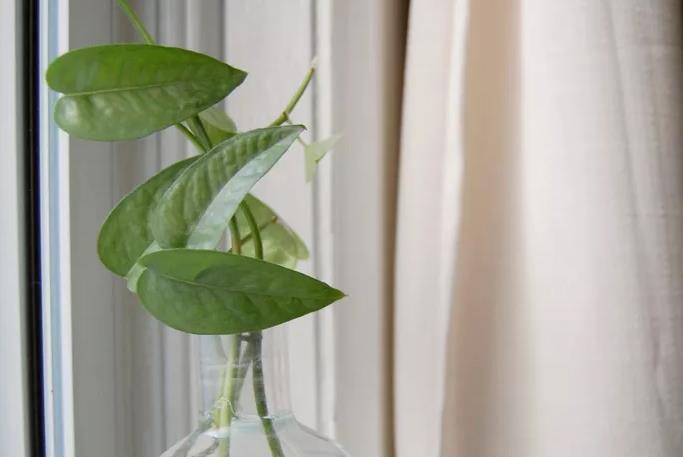
Wilting or Curled Leaves
If your Cebu blue pothos is exhibiting wilting or curled leaves, it most likely needs a good watering. The leaves should return to normal a few hours after being watered. If the leaves don’t perk back up, it may mean that the roots of the plant have dried up due to underwatering, and you should check the root system to be sure. If the roots are dried and shriveled, you can propagate the healthy stems of the plant to bring your pothos back to life.
Slow Growth
The most common cause of delayed growth for Cebu blue pothos is lack of light. Try moving your plant to a location that receives bright, indirect light to encourage more vigorous growth.
FAQ
Do Cebu blue pothos grow fast?
Cebu blue pothos are considered fast growers under the right conditions. If you feel that your pothos is growing slowly, ensure that it is receiving enough light and water to support healthy growth.
Why does my Cebu blue pothos have yellow leaves?
Unfortunately, yellow leaves can be the result of a number of different problems—from too much light to underwatering, to lack of humidity. It is best to assess your plant’s unique growing situation to figure out what the root cause of the yellowing leaves may be.
Learn More: Why Are My Pothos Leaves Turning Yellow?
Do Cebu blue pothos climb?
Cebu blue pothos, like all types of pothos, are vining epiphytes that naturally climb trees and large plants in their native environment. Juvenile Cebu blue pothos can also be successfully grown in hanging planters, but mature plants are vigorous climbers that require a pole or trellis in order to thrive.
Learn More: How to Create a Moss Pole for Your Indoor Plants
Pothos vs. Philodendron: What's the Difference?
Common Name Cebu blue pothos, blue pothos
Botanical Name Epipremnum pinnatum 'Cebu Blue'
Family Araceae
Plant Type Evergreen, vine
Mature Size 8 ft. long indoors, 40 ft. long outdoors
Sun Exposure Partial
Soil Type Moist but well-drained
Soil pH Acidic, neutral, alkaline
Hardiness Zones 9-11, USA
Native Area Asia
Cebu Blue Pothos Care
As with most of its relatives in the pothos family, the Cebu blue pothos is easy to grow and care for. While it grows naturally outdoors in the Philippines, this pothos is most commonly grown indoors as a houseplant in the United States.
There are two unique growth phases of the Cebu blue pothos: juvenile and mature. The juvenile phase is the most recognizable and is characterized by the familiar small, elongated oval leaves that are silvery blue-green in color. The mature phase is usually only observed in plants that are grown outdoors and is characterized by larger green leaves that develop fenestrations over time.

When it comes to care, the biggest difference between these two phases is the growth habit—while all Cebu blue pothos can be trained to grow up a moss pole or trellis, mature Cebu blue pothos are vigorous climbers and do not grow well without support. Otherwise, both juvenile and mature Cebu blue pothos are relatively easy to grow.
Light
To encourage strong, healthy growth, choose a location for your Cebu blue pothos that receives medium to bright indirect light. Unlike other varieties of pothos such as golden pothos or jade pothos, Cebu blue pothos do not do well in low light for extended periods of time. It is also best to avoid direct sunlight as their leaves burn easily.
Soil
Like all pothos plants, the Cebu blue pothos requires moist but well-draining soil. A mixture of one part potting soil, one part orchid bark, and one part perlite provides the perfect amount of drainage.
Water
Allow the top 1 to 2 inches of soil to dry between waterings and then water thoroughly, allowing the excess water to drain from the bottom of the pot. The Cebu blue pothos can handle some extended periods between watering if needed but it will grow best with regular watering. Keep in mind that in the winter months, you should cut back on watering slightly to avoid overwatering while the plant is dormant.
Temperature and Humidity
While the Cebu blue pothos is native to the tropical climate of the Philippines, it does surprisingly well growing indoors. If possible, provide your Cebu blue pothos with extra humidity which will encourage vigorous growth. Placing a humidifier nearby is one of the best ways to increase humidity around a plant, or you can choose a naturally humid location such as a bathroom, laundry room, or kitchen to display your plant. This pothos does not tolerate cold temperatures, so avoid drafty windows in the winter.
Fertilizer
During the spring and summer, apply a balanced liquid fertilizer once a month. Stop fertilizing in the early fall months as the pothos begins to enter dormancy.
Propagating Cebu Blue Pothos
Cebu blue pothos are easy and fun to propagate. Propagating is a great way to repurpose stem cuttings from pruning, or encourage a fuller growth habit. Since these plants can be difficult to come by, propagating is also a great way to create new plants to share with friends or fellow plant lovers.
There are two ways to propagate Cebu blue pothos: in water and in sphagnum moss. To propagate this pothos in water, follow these steps:
Take cuttings from your plant using a pair of sharp pruning shears or scissors. Ensure there are at least 5 to 6 leaves on each stem cutting.
Remove the lower 2 to 3 leaves from the fresh cuttings to expose the nodes along the stem.
Place the stem cuttings in water, submerging the exposed nodes while leaving the remaining leaves above water.
Change the water every week to keep it fresh. Roots should begin growing within 2-3 weeks.
Once the roots are at least 1 to 2 inches long, the cuttings can be transferred to soil.
Fill a small pot with a well-draining potting mixture and moisten the soil slightly.
Transfer the rooted cuttings into the pot and place it in a location that receives medium to bright indirect light. Keep the soil evenly moist for the first 1 to 2 weeks to help the roots acclimate, and then resume a regular watering schedule.
To propagate a Cebu blue pothos in sphagnum moss, follow these steps:
Before you start, place your sphagnum moss in a bowl of water to soak for 10 to 15 minutes.
While the moss is soaking, take cuttings from your plant using a pair of sharp pruning shears or scissors. Ensure there are at least 5 to 6 leaves on each stem cutting.
Remove the lower 2 to 3 leaves from the fresh cuttings to expose the nodes along the stem.
Drain the water from the sphagnum moss and squeeze the leftover water from the moss—then place the moss in a small pot or container (clear plastic pots are great for this).
Place the fresh cuttings in the sphagnum moss—ensuring that the exposed nodes are fully covered by moss while the leaves of the cuttings are exposed to air.
To help increase humidity around the moss, cover the pot or container with a plastic resealable bag, ensuring that the leaves are left out of the bag.
Keep the moss evenly moist (but not soaking) by misting it every week. Roots should begin to form within 2 to 3 weeks. Resist the urge to check in on the roots too early to avoid damaging them.
Once the roots are at least 1 to 2 inches long, you can begin transferring the cuttings to soil. Gently remove the cuttings from the sphagnum moss. Don’t worry too much about picking any moss off that is stuck to the roots as they are delicate. Any leftover moss will get mixed in with the new soil mixture.
Fill a small pot with a well-draining potting mixture and moisten the soil slightly.
Transfer the rooted cuttings into the pot and place it in a location that receives medium to bright indirect light. Keep the soil evenly moist for the first 1 to 2 weeks to help the roots acclimate, and then resume a regular watering schedule.
Common Pests
This pothos is susceptible to some common houseplant pests that you should keep an eye out for. Mealybugs and scale are sap-sucking pests that damage the leaves of the plant over time. They both leave a sticky residue on the leaves and stem of a plant which is one of the first indications that you are dealing with an infestation. Fungus gnats are another common houseplant pest that are attracted to pothos plants thanks to their moist soil. These flying pests lay their eggs in the soil, and their larvae feed on the plant’s root system.
Common Problems With Cebu Blue Pothos
The most common problems with Cebu blue pothos arise from improper watering or light conditions. For the most part however, these pothos are relatively problem-free.
Leaves Turning Yellow
One of the most common problems with Cebu blue pothos is yellowing leaves. Unfortunately, yellow leaves can be the result of a number of different problems—from too much light, underwatering, and to lack of humidity. It is best to assess your plant’s unique growing situation to figure out what the root cause of the yellowing leaves may be.

Wilting or Curled Leaves
If your Cebu blue pothos is exhibiting wilting or curled leaves, it most likely needs a good watering. The leaves should return to normal a few hours after being watered. If the leaves don’t perk back up, it may mean that the roots of the plant have dried up due to underwatering, and you should check the root system to be sure. If the roots are dried and shriveled, you can propagate the healthy stems of the plant to bring your pothos back to life.
Slow Growth
The most common cause of delayed growth for Cebu blue pothos is lack of light. Try moving your plant to a location that receives bright, indirect light to encourage more vigorous growth.
FAQ
Do Cebu blue pothos grow fast?
Cebu blue pothos are considered fast growers under the right conditions. If you feel that your pothos is growing slowly, ensure that it is receiving enough light and water to support healthy growth.
Why does my Cebu blue pothos have yellow leaves?
Unfortunately, yellow leaves can be the result of a number of different problems—from too much light to underwatering, to lack of humidity. It is best to assess your plant’s unique growing situation to figure out what the root cause of the yellowing leaves may be.
Learn More: Why Are My Pothos Leaves Turning Yellow?
Do Cebu blue pothos climb?
Cebu blue pothos, like all types of pothos, are vining epiphytes that naturally climb trees and large plants in their native environment. Juvenile Cebu blue pothos can also be successfully grown in hanging planters, but mature plants are vigorous climbers that require a pole or trellis in order to thrive.
Learn More: How to Create a Moss Pole for Your Indoor Plants
0
0
成长记
Shannah
2019年11月08日

I now added "Epipremnum Aureum (golden pothos / devil’s ivy)" in my "garden"
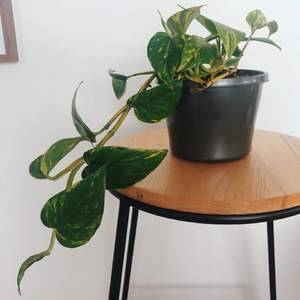

0
0




